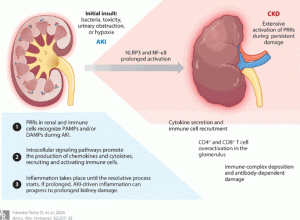Kidney diseases present a complex interplay between the immune system and renal physiology, with immune responses playing a pivotal role in both acute and chronic kidney conditions. The latest research sheds light on the intricate relationship between the kidneys and the immune system, emphasizing the dual role of immune components in both pathogenic and protective mechanisms (Figure 1).

Figure 1: Mechanism of AKI progressing to CKD. AKI may progress to CKD over time. The risk of developing CKD following an episode of AKI is influenced by many factors directly related to severity and duration of AKI, cause of injury, and comorbidities. Other intrinsic risks for the progression of CKD include preterm birth, Darwinian selection for mutations, and particularly modern lifestyle. AKI and CKD are the early and late stages, respectively, of interrelated disorders. AKI provokes an immunological reaction to the acute loss of renal function. If excessive, such an inflammatory response may cause additional renal damage and delay recovery. For instance, necrotic tubular epithelial cells activate pro-inflammatory macrophages via the activation of the NLRP3 inflammasome. Besides, persistence of the NF-κB system following NLRP3 inflammasome activation provides a plausible explanation for the transition from AKI to CKD. The long-term accumulation of immune cells in the kidney can contribute to fibrosis and cause chronic tissue damage. In conclusion, the immune system has a multi-faceted and majorly complicated role in the development of CKD. Abbreviations: DAMPs, danger-associated molecular patterns; PAMPs, pathogen-associated molecular patterns; PRRs, pattern recognition receptors. Figure adapted from images created with BioRender.com.
Historical Context and Kidney Immunology
The connection between the immune system and kidney disease dates back to studies in the 1960s, where it was first observed that immune cells like polymorphonuclear leukocytes contributed to glomerular damage. Over the years, it became clear that various immune cells, including T cells, monocytes, and macrophages, are intricately involved in the pathogenesis of conditions like glomerulonephritis and lupus nephritis.
The kidney’s filtration units, nephrons, play a crucial role in clearing metabolic waste, thus maintaining immune equilibrium by limiting local and systemic inflammation. This process is mediated by renal-resident immune cells, such as macrophages and dendritic cells (DCs), which are strategically located to detect and eliminate potential threats. These cells also contribute to immune tolerance under healthy conditions but can promote inflammation and injury in disease states.
Immune Response in Acute Kidney Injury (AKI)
Acute Kidney Injury (AKI) is a significant health challenge, often triggered by factors such as sepsis, toxins, and ischemia. The immune system’s response in AKI is characterized by the rapid activation of innate immune cells, including neutrophils and macrophages. These cells release a cascade of pro-inflammatory cytokines, exacerbating tissue damage. Research has highlighted the role of pattern recognition receptors (PRRs) like Toll-like receptors (TLRs) and Nod-like receptors (NLRs) in recognizing damage-associated molecular patterns (DAMPs) and driving inflammatory responses.
Interestingly, while innate immune responses are crucial for the initial defence, they can also contribute to the progression of AKI to chronic kidney disease (CKD). The persistence of inflammatory signals, such as those mediated by the NLRP3 inflammasome, leads to chronic inflammation and fibrosis, bridging the transition from AKI to CKD.
Chronic Kidney Disease (CKD) and Immune Dysregulation
CKD affects millions globally and is marked by a progressive decline in kidney function. The immune system plays a central role in CKD progression, where chronic inflammation driven by innate immune cells like macrophages and adaptive immune responses involving T and B cells leads to sustained tissue damage. In CKD, the imbalance between pro-inflammatory and regulatory immune mechanisms becomes evident, with factors like uraemia further impairing immune cell function.
One of the critical challenges in CKD is the immune system’s paradoxical role, where it is both hyperactive, leading to chronic inflammation, and impaired, resulting in increased susceptibility to infections. This duality complicates the management of CKD, as therapies need to balance controlling inflammation while boosting immune competence.
Innovations in Immunomodulation and Kidney Disease
Recent advances in immunology and nephrology have opened new avenues for understanding and treating kidney diseases. For instance, in silicon models and kidney organoids are being utilized to study the interactions between immune cells and renal tissue, offering insights into disease mechanisms and potential therapeutic targets. Moreover, novel immunomodulatory therapies are being explored to prevent the progression of kidney diseases by targeting specific immune pathways.
Research into targeted therapies, such as those modulating the TLR and NLR pathways or inhibiting the NLRP3 inflammasome, shows promise in mitigating the inflammatory responses that drive kidney injury. These approaches aim to preserve kidney function by reducing inflammation and preventing fibrosis.
Conclusion
The immune system’s role in kidney disease is a double-edged sword, with its components involved in both protection and pathology. Understanding this complex relationship is crucial for developing effective therapies that can prevent the progression of kidney diseases while maintaining immune homeostasis. As research continues to unravel the intricacies of renal immunology, the future holds promise for more targeted and effective treatments for kidney disease.
Journal article: Foresto-Neto, O., et al. 2024 .Immunology of Kidney Disease. Annual Review of Immunology.
Summary by Faith Oluwamakinde










